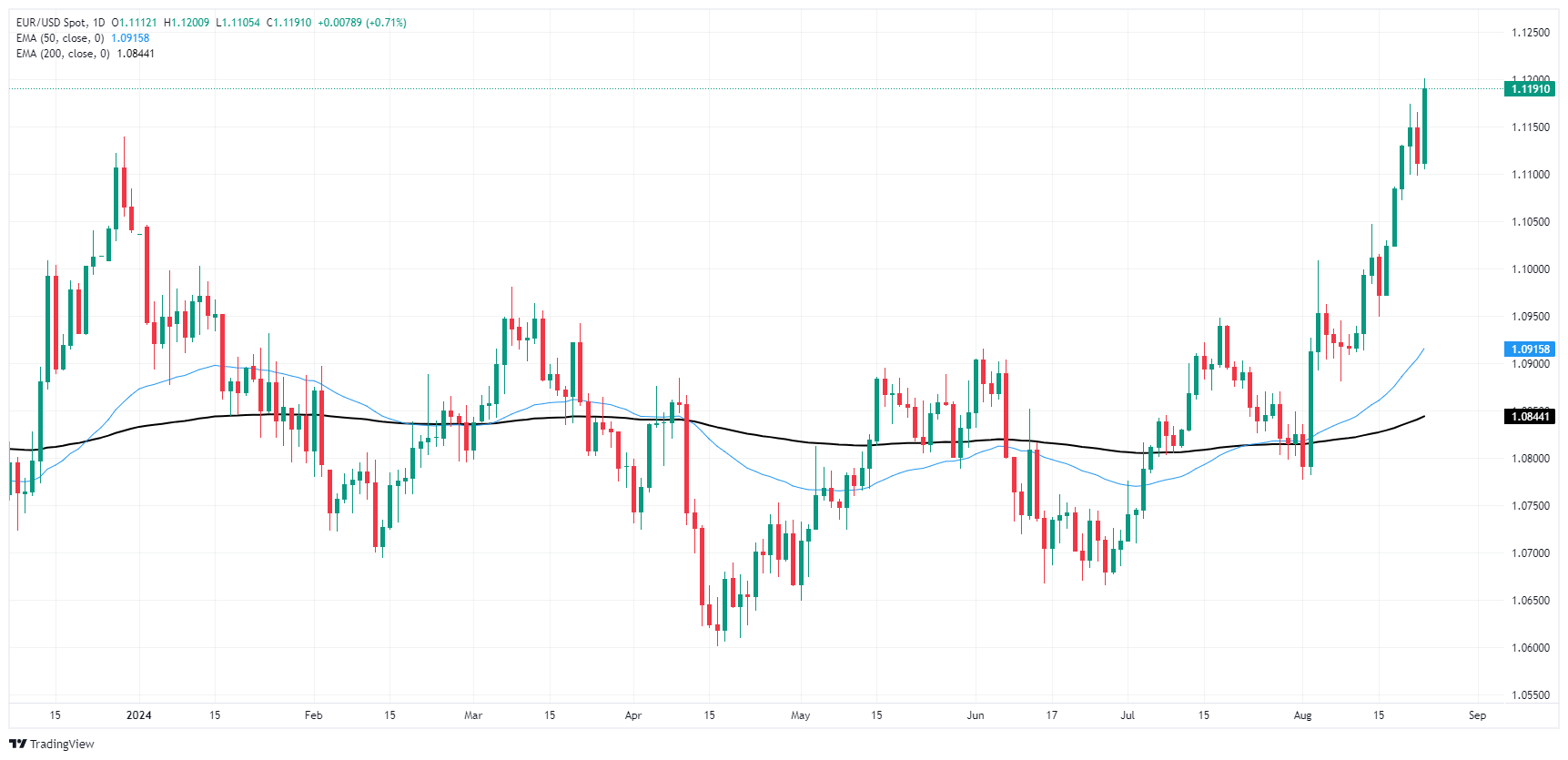- EUR/USD tipped into 1.1300 for the first time in over a year on Friday.
- Fed policymakers open the door to rate cuts during Jackson Hole.
- Coming up next week: key EU and US inflation prints.
EUR/USD rallied into its second-best day of August, climbing seven-tenths of one percent as the US Dollar tumbles across the board. Market risk appetite is pinned into the ceiling after Federal Reserve (Fed) officials broadly tipped their hand to investors, signalling that the US central bank is finally ready to start cutting interest rates.
Forecasting the Coming Week: Recession concerns take over Fed’s easing
According to the CME’s FedWatch Tool, rate markets are pricing in roughly three-to-one odds of a double cut on September 18, with the rest of the rate board still committed to a single quarter-point cut. Bets of a 50 bps opening rate trim in September rose after Fed Chairman Jerome Powell, while speaking at the Jackson Hole Economic Symposium on Friday, openly admitted that the time has finally come for the US central bank to begin pushing reference rates down.
Coming up: EU, US inflation metrics loom ahead late next week
Next week will open with a notably quiet data docket, however key inflation data points for both the EU and the US loom ahead in the darkness. US Gross Domestic Product (GDP) growth figures will serve as a precursor event on Thursday, but Fiber traders will broadly be focusing on an inflation double header slated for next Friday.
Preliminary EU Harmonized Index of Consumer Prices (HICP) inflation figures for August will kick off next Friday’s data docket, and the figures are widely forecast to show key EU inflation metrics continuing to cool toward the 2% annualized target set by the European Central Bank (ECB). On the US side, Personal Consumption Expenditure Price Index (PCE) inflation is expected to hold steady above the Fed’s own desired 2% target, with core PCE inflation for the year ended in July set to come in at or near the previous period’s 2.6%.
EUR/USD price forecast
Despite some hitches along the way, Fiber managed to squeeze out a fresh 13-month high on Friday, testing chart territory north of 1.1300. Despite a firm bullish presence in the order flow, intraday price action struggled to hold the key price level, but still wrapped up the trading week with a solid 1.51% gain, one of the pair’s best single-week performances since November of last year.
EUR/USD bids continue to stretch higher after the pair caught a bounce from the last swing low into the 200-day Exponential Moving Average (EMA) rising into 1.0850. Without a convincing break of 1.1300 on the table, bidders could see renewed short interest dragging price action back into the low side in the near-term.
EUR/USD daily chart
Euro FAQs
The Euro is the currency for the 20 European Union countries that belong to the Eurozone. It is the second most heavily traded currency in the world behind the US Dollar. In 2022, it accounted for 31% of all foreign exchange transactions, with an average daily turnover of over $2.2 trillion a day. EUR/USD is the most heavily traded currency pair in the world, accounting for an estimated 30% off all transactions, followed by EUR/JPY (4%), EUR/GBP (3%) and EUR/AUD (2%).
The European Central Bank (ECB) in Frankfurt, Germany, is the reserve bank for the Eurozone. The ECB sets interest rates and manages monetary policy. The ECB’s primary mandate is to maintain price stability, which means either controlling inflation or stimulating growth. Its primary tool is the raising or lowering of interest rates. Relatively high interest rates – or the expectation of higher rates – will usually benefit the Euro and vice versa. The ECB Governing Council makes monetary policy decisions at meetings held eight times a year. Decisions are made by heads of the Eurozone national banks and six permanent members, including the President of the ECB, Christine Lagarde.
Eurozone inflation data, measured by the Harmonized Index of Consumer Prices (HICP), is an important econometric for the Euro. If inflation rises more than expected, especially if above the ECB’s 2% target, it obliges the ECB to raise interest rates to bring it back under control. Relatively high interest rates compared to its counterparts will usually benefit the Euro, as it makes the region more attractive as a place for global investors to park their money.
Data releases gauge the health of the economy and can impact on the Euro. Indicators such as GDP, Manufacturing and Services PMIs, employment, and consumer sentiment surveys can all influence the direction of the single currency. A strong economy is good for the Euro. Not only does it attract more foreign investment but it may encourage the ECB to put up interest rates, which will directly strengthen the Euro. Otherwise, if economic data is weak, the Euro is likely to fall. Economic data for the four largest economies in the euro area (Germany, France, Italy and Spain) are especially significant, as they account for 75% of the Eurozone’s economy.
Another significant data release for the Euro is the Trade Balance. This indicator measures the difference between what a country earns from its exports and what it spends on imports over a given period. If a country produces highly sought after exports then its currency will gain in value purely from the extra demand created from foreign buyers seeking to purchase these goods. Therefore, a positive net Trade Balance strengthens a currency and vice versa for a negative balance.
Information on these pages contains forward-looking statements that involve risks and uncertainties. Markets and instruments profiled on this page are for informational purposes only and should not in any way come across as a recommendation to buy or sell in these assets. You should do your own thorough research before making any investment decisions. FXStreet does not in any way guarantee that this information is free from mistakes, errors, or material misstatements. It also does not guarantee that this information is of a timely nature. Investing in Open Markets involves a great deal of risk, including the loss of all or a portion of your investment, as well as emotional distress. All risks, losses and costs associated with investing, including total loss of principal, are your responsibility. The views and opinions expressed in this article are those of the authors and do not necessarily reflect the official policy or position of FXStreet nor its advertisers. The author will not be held responsible for information that is found at the end of links posted on this page.
If not otherwise explicitly mentioned in the body of the article, at the time of writing, the author has no position in any stock mentioned in this article and no business relationship with any company mentioned. The author has not received compensation for writing this article, other than from FXStreet.
FXStreet and the author do not provide personalized recommendations. The author makes no representations as to the accuracy, completeness, or suitability of this information. FXStreet and the author will not be liable for any errors, omissions or any losses, injuries or damages arising from this information and its display or use. Errors and omissions excepted.
The author and FXStreet are not registered investment advisors and nothing in this article is intended to be investment advice.
Recommended content
Editors’ Picks

EUR/USD under pressure near 1.0350 after mixed sentiment data
EUR/USD remains in the negative territory near 1.0350 in the European session on Tuesday, erasing a portion of Monday's gains. The pair is undermined by risk aversion and the US Dollar demand, fuelled by US President Trump's tariff threats, and mixed sentiment data.

GBP/USD drops to 1.2250 area on broad USD strength
GBP/USD stays under bearish pressure and trades deep in the red near 1.2250 on Tuesday as the USD gathers strength following US President Trump's tariff threats. The data from the UK showed that the ILO Unemployment Rate edged higher to 4.4% in the three months to November.

Gold price eases from over two-month top on stronger USD, positive risk tone
Gold price (XAU/USD) retreats slightly after touching its highest level since November 6 during the early European session on Tuesday and currently trades just below the $2,725 area, still up over 0.50% for the day.

Bitcoin fails to sustain the $109K mark after Trump’s inauguration
Bitcoin’s price steadies above the $102,000 mark on Tuesday after reaching a new all-time high of $109,588 the previous day. Santiment’s data shows that BTC prices quickly corrected, as social media showed major greed and FOMO among the traders in Bitcoin after President Donald Trump’s inauguration.

Five keys to trading Trump 2.0 with Gold, Stocks and the US Dollar Premium
"I have the best words" – one of Donald Trump's famous quotes represents one of the most significant shifts to trading during his time. Words from the president may have a more significant impact than economic data.

Trusted Broker Reviews for Smarter Trading
VERIFIED Discover in-depth reviews of reliable brokers. Compare features like spreads, leverage, and platforms. Find the perfect fit for your trading style, from CFDs to Forex pairs like EUR/USD and Gold.